Maximizing Sales Success with Effective Follow-up Strategies: 30 Ready-to-Use Templates
Welcome to Sales Follow-up Letters! At Sales Follow-up Letters, we understand the importance of effective communication in the sales process. Our mission is to equip you with the tools and strategies you need to excel in your follow-up efforts and drive remarkable results. Whether you’re looking to nurture leads, convert prospects into customers, or build stronger relationships with existing clients, our website is your go-to resource for expert guidance and practical tips on crafting impactful follow-up letters. Explore our comprehensive collection of templates, best practices, and resources to elevate your follow-up game and achieve unparalleled success. Get ready to revolutionize your sales approach and unlock the potential of meaningful follow-up interactions. Welcome to a world of endless possibilities with Sales Follow-up Letters!
Benefits of Effective Follow-up
- Increased Conversion Rates: Following up with prospects and customers increases the likelihood of closing a sale or securing a business opportunity. By staying engaged with leads and addressing their concerns, you can nurture their interest and guide them toward making a purchase decision.
- Improved Customer Satisfaction: Prompt and personalized follow-up demonstrates your commitment to customer satisfaction. It allows you to address any issues, provide additional information, or offer support, ensuring that customers feel valued and supported throughout their journey.
- Stronger Customer Relationships: Regular follow-up interactions help build stronger relationships with customers. By maintaining consistent communication, you can establish trust, understand their evolving needs, and tailor your offerings to better meet their expectations.
- Increased Customer Loyalty: Effective follow-up shows your dedication to customer success beyond the initial sale. By consistently engaging with customers and providing ongoing support, you foster loyalty and increase the likelihood of repeat purchases and referrals.
- Opportunities for Upselling or Cross-selling: Follow-up interactions present opportunities to introduce customers to new products, services, or upgrades that complement their initial purchase. By highlighting relevant offerings, you can increase the average transaction value and maximize customer lifetime value.
- Valuable Feedback and Insights: Following up with customers provides an opportunity to gather feedback on their experience, product usage, or any challenges they may be facing. This feedback can be invaluable for product development, process improvement, and enhancing the overall customer experience.
- Competitive Advantage: Consistent and thoughtful follow-up sets you apart from competitors who may neglect this important step. By demonstrating proactive engagement and personalized attention, you position yourself as a trusted and reliable partner in the eyes of your prospects and customers.
#1: Thank You for Your Time and Interest:
Express gratitude for the prospect’s time and interest in your product or service, reinforcing a positive impression. The purpose of this “Thank You for Your Time and Interest” letter is to express sincere gratitude to the prospect for investing their valuable time and showing interest in your product or service. This letter serves as an opportunity to reinforce a positive impression and appreciation for the prospect’s engagement. By expressing gratitude, you aim to strengthen the relationship and leave a lasting impression that reflects your professionalism and genuine interest in their needs. Such a letter can be used after a sales presentation, meeting, or any interaction where the prospect has shown interest in your offerings.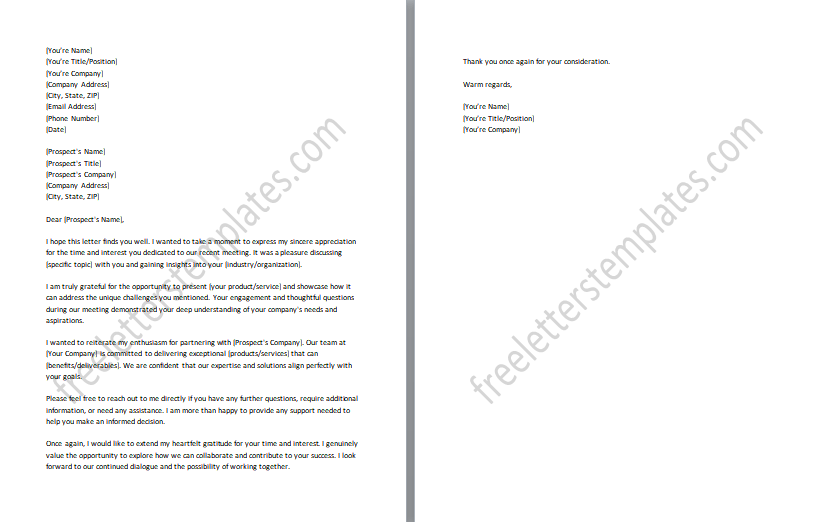
#2: Following Up on Our Recent Meeting:
Acknowledge a recent meeting or discussion, recap key points, and suggest the next steps. The purpose of this “Following Up on Our Recent Meeting” letter is to acknowledge the recent meeting or discussion with the prospect and provide a concise recap of the key points discussed. This letter aims to reinforce the prospect’s understanding of the discussed topics, reiterating any agreements or decisions made during the meeting. Additionally, it suggests the next steps to be taken, outlining the actions that both parties need to undertake to move forward in the sales process. The letter serves as a professional follow-up to maintain momentum and ensure clear communication between you and the prospect after the meeting.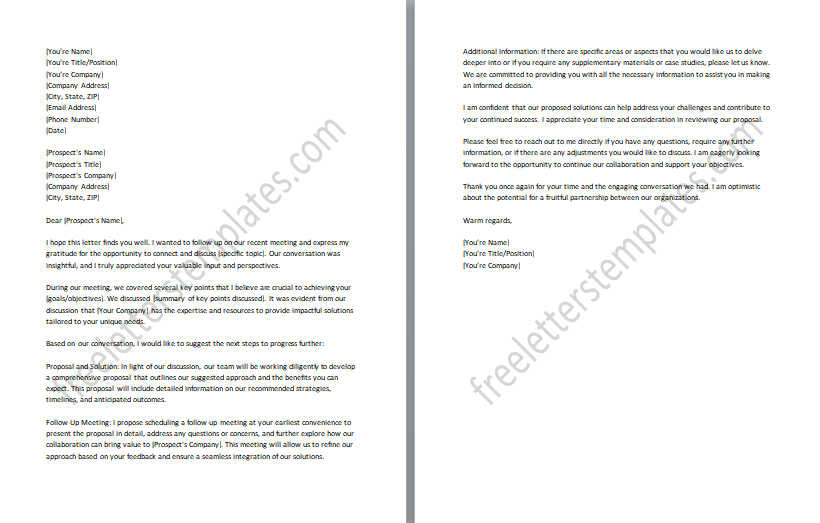
#3: Checking In on Your Decision-Making Process:
Inquire about the prospect’s progress in their decision-making process and offer any additional assistance they may need. The purpose of this “Checking In on Your Decision-Making Process” letter is to inquire about the prospect’s progress in their decision-making process and offer ongoing support and assistance. This letter aims to maintain open communication and demonstrate your genuine interest in helping the prospect make an informed decision. The letter serves as a proactive approach to nurture the prospect’s decision-making process and maintain a positive relationship throughout the sales journey.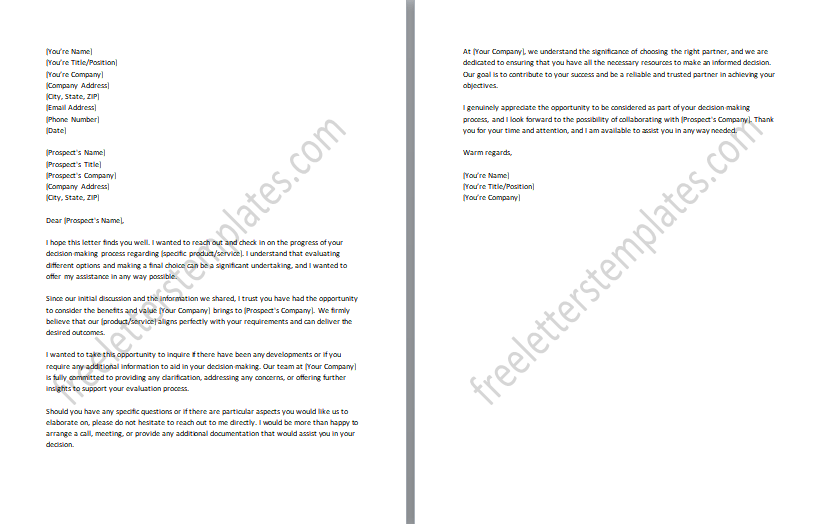
#4: Addressing Any Concerns or Objections:
Address specific concerns or objections raised by the prospect and provide further clarification or information to overcome them. The purpose of this “Addressing Any Concerns or Objections” letter is to acknowledge and address specific concerns or objections raised by the prospect during the sales process. This letter aims to provide further clarification or information that can help overcome the prospect’s hesitations or doubts. The letter serves as an opportunity to provide additional information, present alternative perspectives, or offer evidence that can help alleviate their concerns and build confidence in your product or service.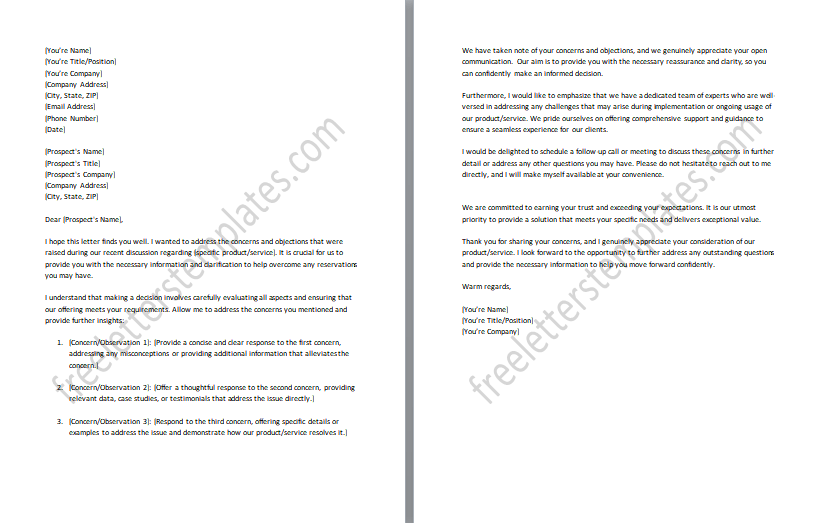
#5: Offering Additional Information or Resources:
Offer additional resources, such as whitepapers, case studies, or videos, to provide more value and support the prospect’s decision-making process. The purpose of this “Offering Additional Information or Resources” letter is to provide the prospect with additional resources that can enhance their decision-making process. By offering these resources, you demonstrate your commitment to helping the prospect make an informed decision and showcase the value your offerings can bring to their organization. This letter serves as a way to provide added value, build credibility, and support the prospect’s evaluation of your solution.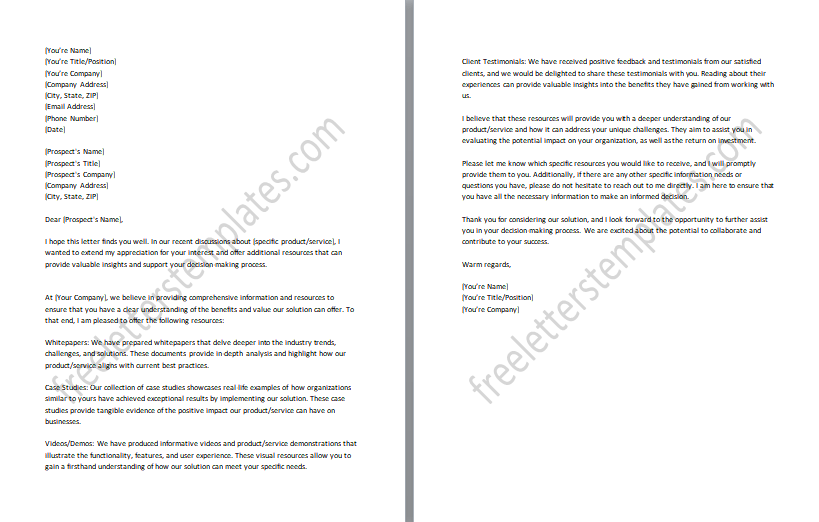
#6: Providing a Personalized Solution:
Tailor your follow-up letter to showcase how your product or service specifically addresses the prospect’s pain points or challenges. The purpose of this “Providing a Personalized Solution” letter is to tailor your follow-up communication to showcase how your product or service directly addresses the prospect’s specific pain points or challenges. This letter aims to demonstrate a deep understanding of the prospect’s needs and present your offering as a personalized solution that can effectively solve their problems or meet their requirements. This letter serves as an opportunity to reinforce the prospect’s confidence in your ability to provide a customized solution and deepen the connection between their needs and your offerings.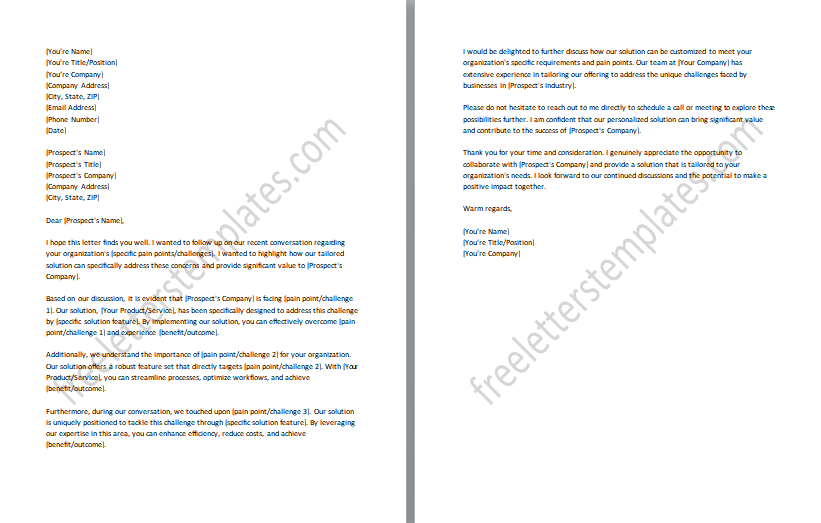
#7: Reiterating the Key Benefits of Your Product/Service:
Recap the primary benefits and advantages of your offering to remind the prospect of its value. The purpose of this “Reiterating the Key Benefits of Your Product/Service” letter is to recap the primary benefits and advantages of your offering, reminding the prospect of its value. This letter aims to reinforce the prospect’s understanding of how your product or service can address their needs, solve their problems, or provide unique advantages. By reiterating the key benefits, you remind the prospect of the value proposition and differentiate your offering from competitors.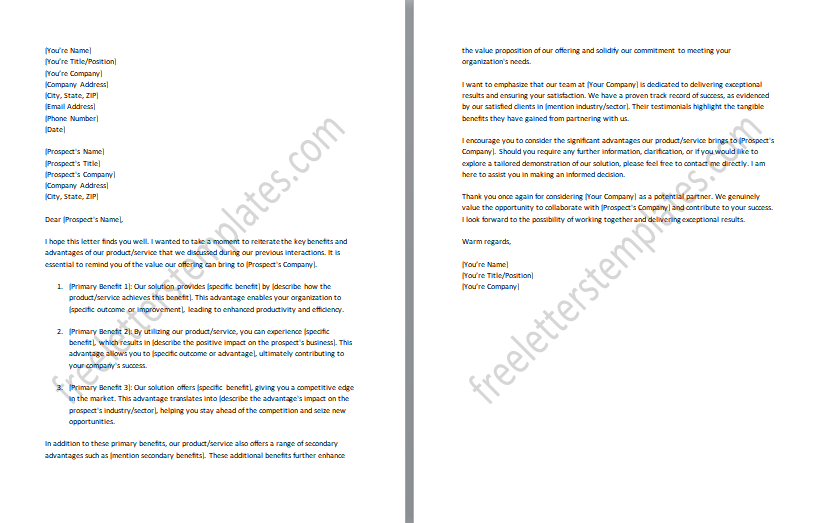
#8: Introducing a Limited-Time Offer or Promotion:
Create a sense of urgency by introducing a limited-time offer or promotion to encourage the prospect to take action. The purpose of this “Introducing a Limited-Time Offer or Promotion” letter is to create a sense of urgency and encourage the prospect to take action by introducing a limited-time offer or promotion. This letter aims to capture the prospect’s attention and convey the importance of acting promptly to avail themselves of the special opportunity. This letter serves as a powerful tool to drive immediate action, increase conversion rates, and incentivize prospects to take advantage of the exclusive benefits available within a specific timeframe.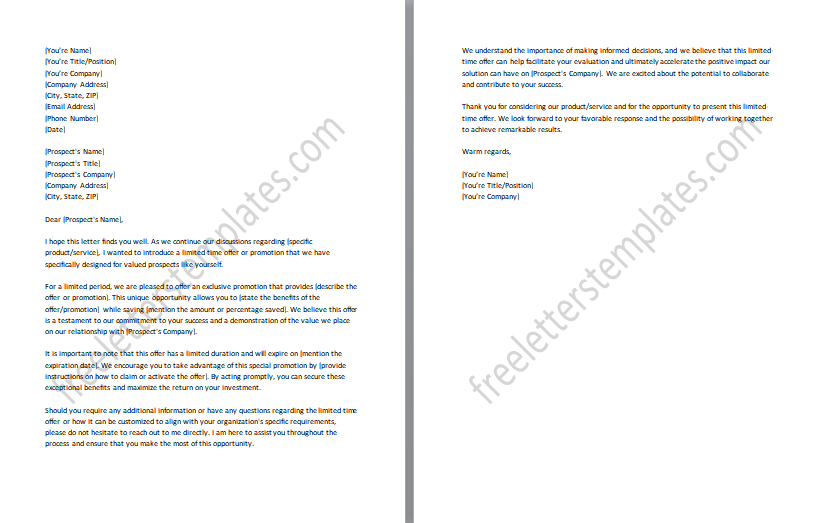
#9: Following Up on a Proposal or Quote:
Follow up on a previously submitted proposal or quote, answer any questions, and provide further clarification if needed. The purpose of this “Following Up on a Proposal or Quote” letter is to initiate a follow-up communication after submitting a proposal or quote to the prospect. This letter serves as an opportunity to provide additional context, address any uncertainties, and reaffirm the value and benefits outlined in the proposal or quote. The goal is to foster open communication, address any lingering doubts, and move the sales process forward toward a successful outcome.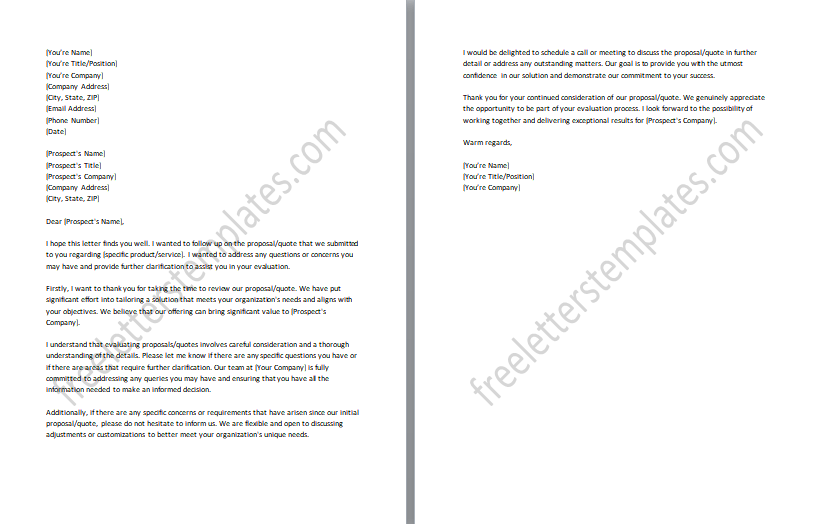
#10: Requesting Feedback on a Demo or Trial:
Ask for feedback on a demo or trial experience, seeking insights into the prospect’s impressions and potential areas for improvement. The purpose of this “Requesting Feedback on a Demo or Trial” letter is to ask the prospect for feedback on their demo or trial experience with your product or service. This letter aims to gather valuable insights into their impressions, experiences, and any areas for improvement. By requesting feedback, you demonstrate your commitment to continuously improving your offerings and ensuring customer satisfaction. This letter serves as a proactive approach to engaging the prospect, understanding their needs, and gathering feedback that can help refine your product or service.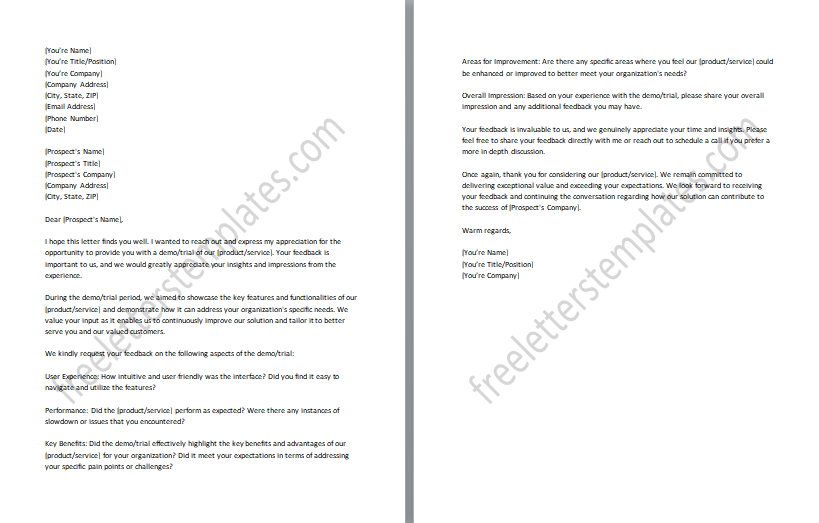
#11: Following Up on a Sample or Trial Period:
Follow up with prospects who have received samples or participated in a trial period, checking if they are ready to make a purchase. The purpose of this “Following Up on a Sample or Trial Period” letter is to reach out to prospects who have received samples or participated in a trial period of your product or service. This letter aims to check in with them, assess their experience with the sample or trial, and determine if they are ready to make a purchase. This letter serves as a gentle nudge to move the prospect further along the sales funnel and convert their trial experience into a successful purchase. The goal is to gather valuable insights, address any remaining hesitations, and guide the prospect toward becoming a satisfied customer.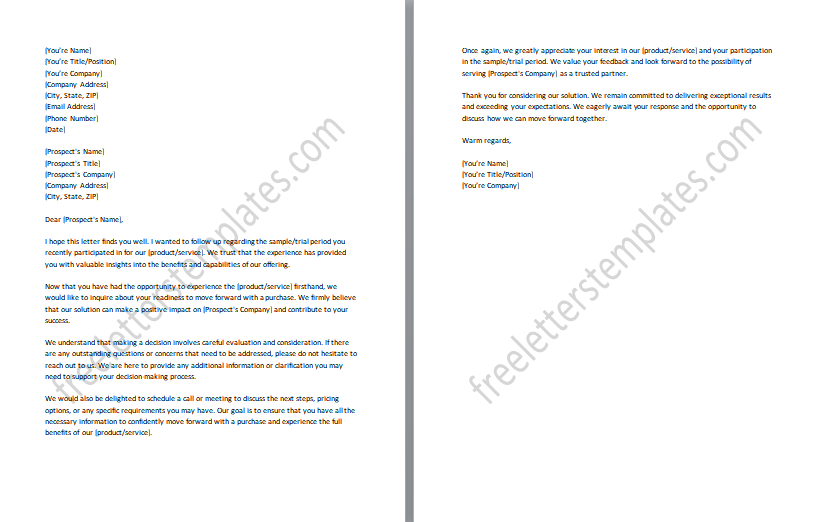
#12: Sharing Success Stories or Case Studies:
Share success stories or case studies of satisfied customers to illustrate the positive outcomes your product or service can deliver. The purpose of this “Sharing Success Stories or Case Studies” letter is to share success stories or case studies of satisfied customers with the prospect. This letter aims to illustrate the positive outcomes and tangible benefits that your product or service can deliver. By sharing real-life examples, you provide social proof and build credibility, showcasing how your offerings have positively impacted other organizations or individuals. This letter serves as a persuasive tool to demonstrate the value and effectiveness of your solution, helping the prospect visualize the potential results they can achieve.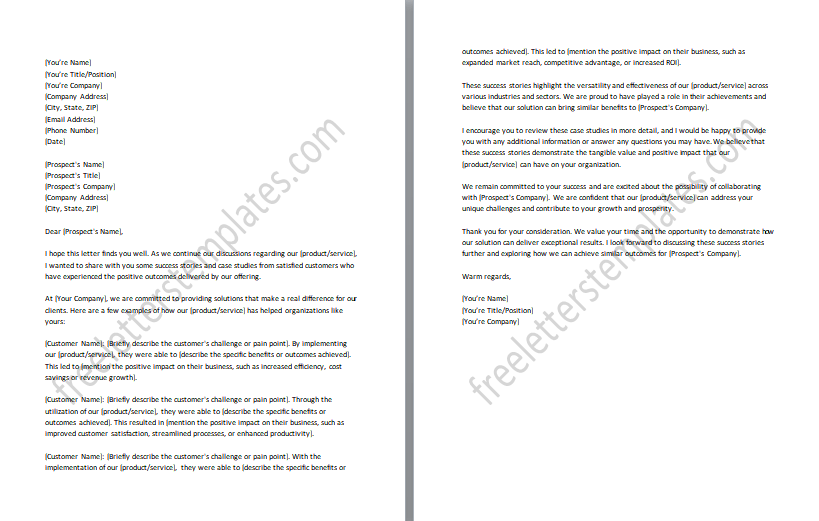
#13: Offering a Product/Service Upgrade or Upsell:
Present an opportunity for an upgrade or upsell, showcasing additional features or benefits that can enhance the prospect’s experience. The purpose of this “Offering a Product/Service Upgrade or Upsell” letter is to present the prospect with an opportunity to upgrade or upsell to a higher-tier product or service. This letter aims to showcase additional features, functionalities, or benefits that can enhance their experience and provide added value. By offering an upgrade or upsell, you demonstrate your commitment to continuously improving your offerings and providing the prospect with the best possible solution. This letter serves as a way to highlight the advantages of the upgraded option and how it aligns with their evolving needs or goals.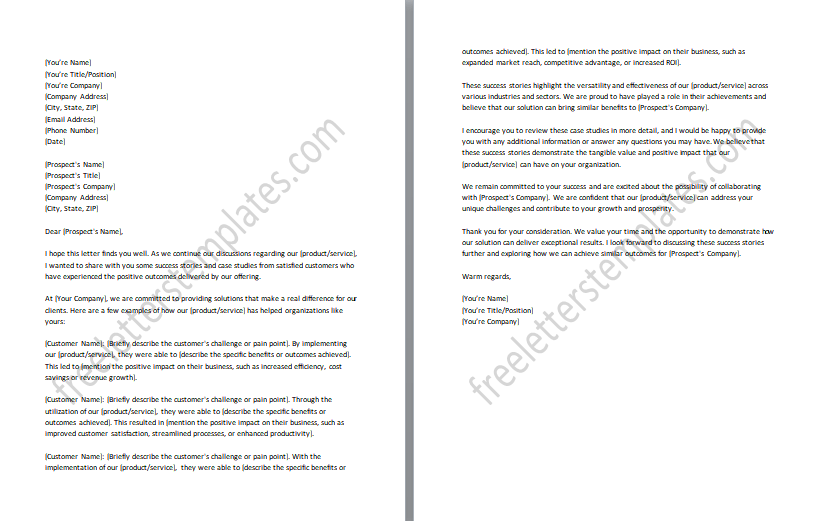
#14: Responding to a Price Negotiation or Request:
Address a prospect’s request for price negotiation, providing alternatives or options to meet their budget or specific needs. The purpose of this “Responding to a Price Negotiation or Request” letter is to address a prospect’s request for price negotiation and provide alternatives or options to meet their budget or specific needs. This letter aims to maintain open and transparent communication while finding a mutually beneficial solution. By responding to the price negotiation or request, you demonstrate flexibility and a willingness to work with the prospect to accommodate their requirements. This letter serves as an opportunity to explore alternative pricing structures, payment plans, or package options that align with their budget.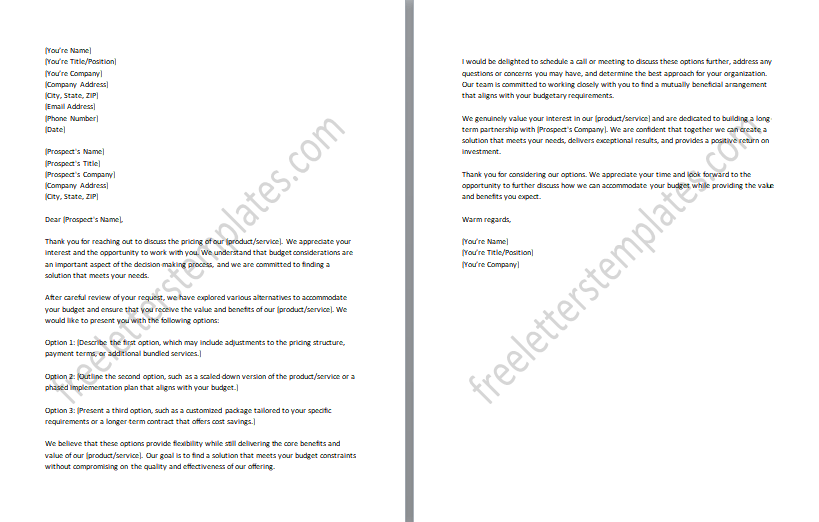
#15: Following Up on a Missed Sales Opportunity:
Revisit prospects who didn’t convert into customers, exploring if any new developments might influence their decision. The purpose of this “Following Up on a Missed Sales Opportunity” letter is to revisit prospects who didn’t convert into customers and explore if there are any new developments that might influence their decision. This letter aims to re-engage with the prospect, understand any reasons behind their initial hesitation, and assess if there have been any changes or updates that could impact their buying decision. This letter serves as a means to rekindle the conversation, address any concerns or objections, and offer additional information or solutions that may help overcome their initial reservations.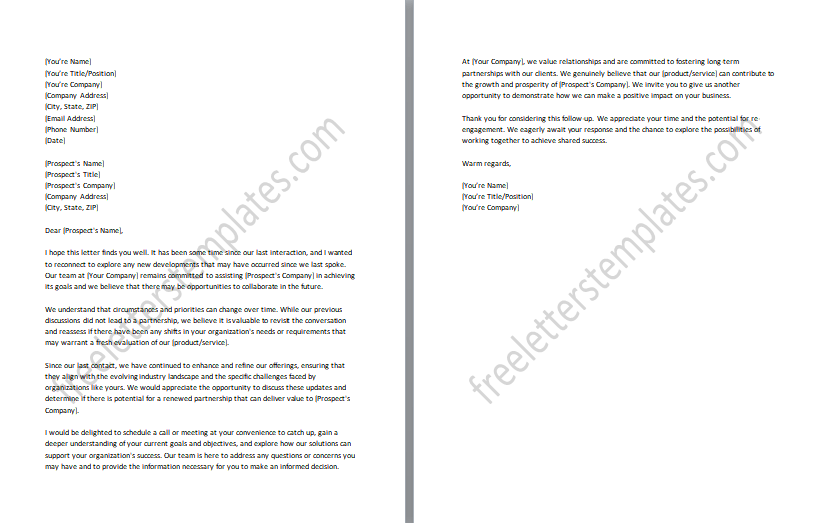
#16: Reconnecting with a Prospect after a Period of Inactivity:
Re-establish contact with a prospect who has been unresponsive, offering a fresh perspective or incentive to re-engage. The purpose of this “Reconnecting with a Prospect after a Period of Inactivity” letter is to re-establish contact with a prospect who has been unresponsive and offer a fresh perspective or incentive to re-engage. This letter aims to revive the conversation, reignite their interest, and encourage them to resume the dialogue. By reaching out after a period of inactivity, you show persistence and a genuine desire to connect with the prospect. This letter serves as an opportunity to provide new insights, updates, or incentives that may capture their attention and motivate them to re-engage.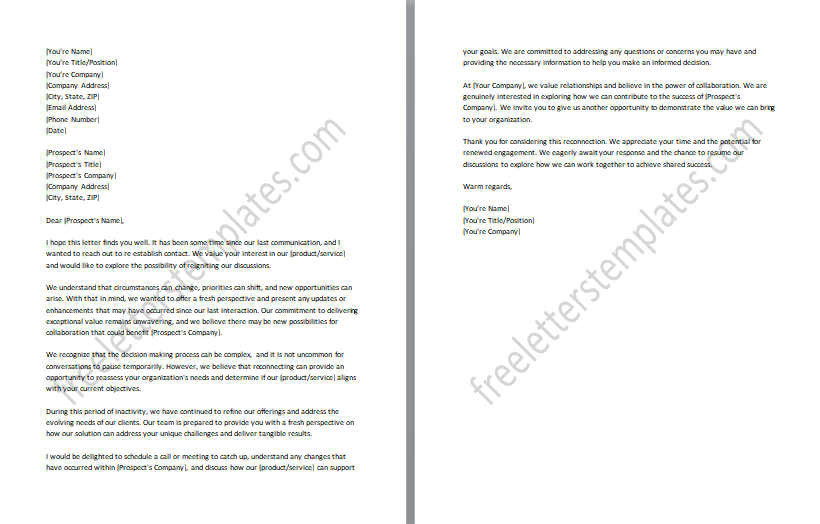
#17: Addressing Competitor Comparison Concerns:
Address any concerns or doubts the prospect may have regarding your product compared to competitors, highlighting unique selling points. The purpose of this “Addressing Competitor Comparison Concerns” letter is to address any concerns or doubts the prospect may have regarding your product compared to competitors and highlight your unique selling points. This letter aims to provide clarity and reassurance to the prospect by addressing their specific concerns and showcasing the advantages of choosing your product over competitors. By proactively addressing the comparison concerns, you demonstrate your understanding of their decision-making process and position your offering in a favorable light. The goal is to alleviate their concerns, build confidence in your solution, and influence their decision in your favor.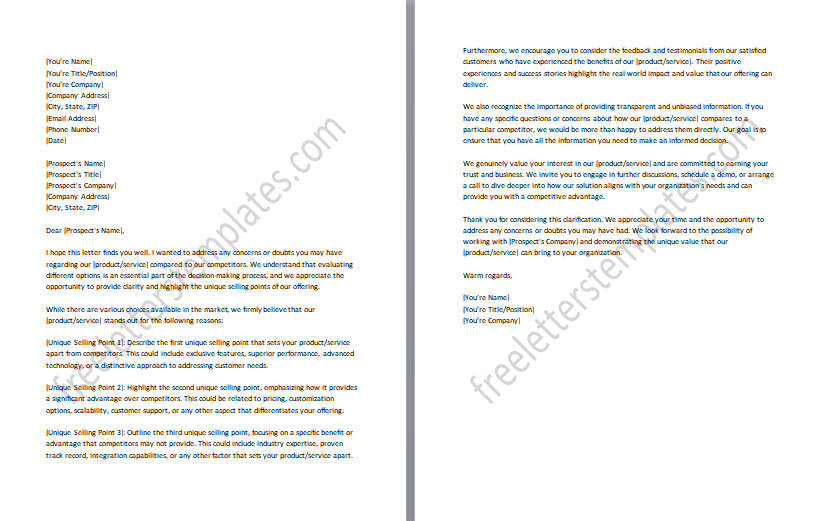
#18: Providing Testimonials or Social Proof:
Share testimonials or social proof from satisfied customers to build credibility and trust in your product or service. The purpose of this “Providing Testimonials or Social Proof” letter is to share testimonials or social proof from satisfied customers to build credibility and trust in your product or service. This letter aims to provide evidence of the positive experiences and outcomes that others have had with your offering. By sharing testimonials or social proof, you demonstrate that your product or service has been successfully utilized and appreciated by real customers. This letter serves as a powerful tool to showcase the tangible benefits, reliability, and effectiveness of your solution.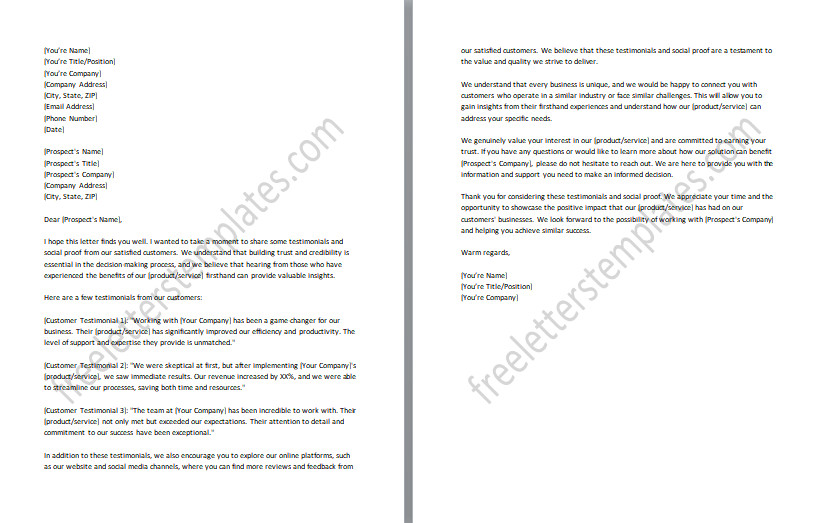
#19: Highlighting New Features or Updates to Your Offering:
Inform prospects about new features, updates, or improvements to your offering to generate renewed interest. The purpose of this “Highlighting New Features or Updates to Your Offering” letter is to inform prospects about new features, updates, or improvements to your product or service to generate renewed interest. This letter aims to keep the prospect informed and engaged by sharing exciting developments that enhance the value and functionality of your offering. This letter serves as an opportunity to showcase how the prospect can benefit from the latest enhancements, addressing any pain points or gaps they may have previously identified. The goal is to pique their curiosity, reignite their interest, and prompt them to reconsider your offering based on the added value and improved capabilities it now provides.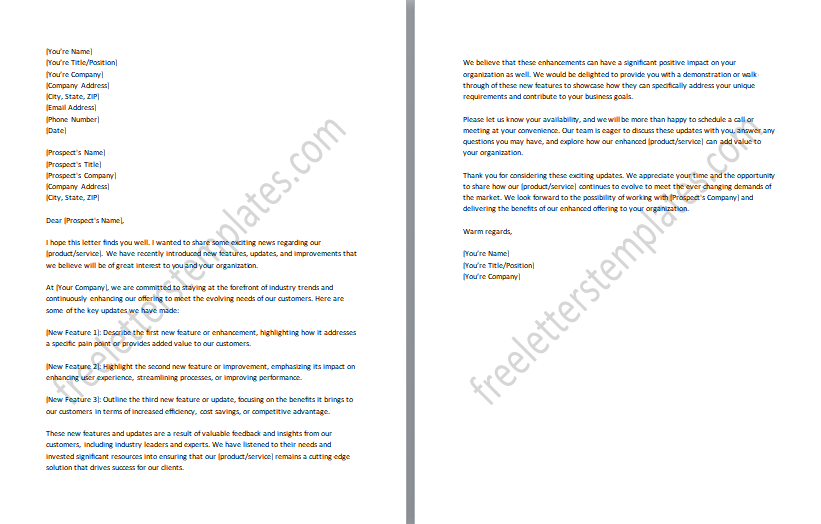
#20: Following Up on a Sales Call or Phone Conversation:
Follow up after a sales call or phone conversation, summarizing the key points discussed and outlining the next steps. The purpose of this “Following Up on a Sales Call or Phone Conversation” letter is to follow up after a sales call or phone conversation, summarizing the key points discussed and outlining the next steps. This letter aims to reinforce the conversation and ensure both parties are aligned on the discussed details. This letter serves as a roadmap for the next steps, outlining the agreed-upon action items, responsibilities, and timelines. The goal is to maintain momentum, foster a clear communication channel, and move the sales process forward in a structured and organized manner.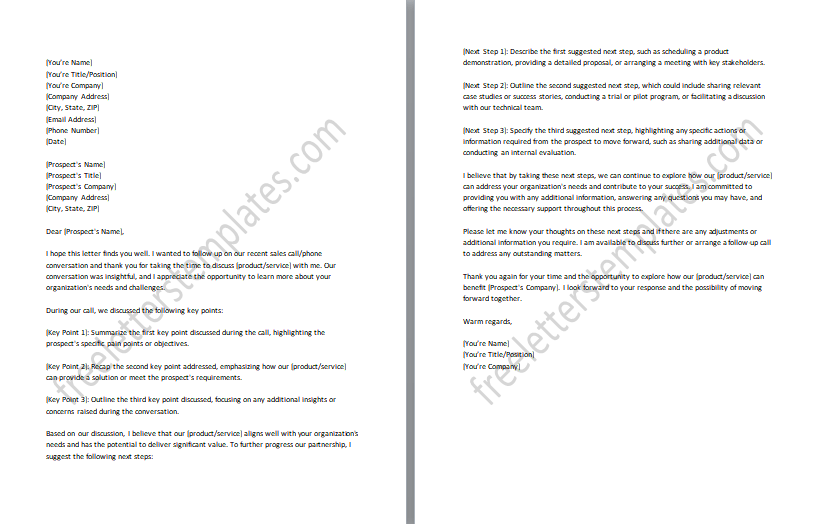
#21: Reaching Out to Nurtured Leads or Warm Prospects:
Contact nurtured leads or warm prospects who have shown interest in the past, checking if they are ready to move forward. The purpose of this “Reaching Out to Nurtured Leads or Warm Prospects” letter is to contact nurtured leads or warm prospects who have shown interest in the past, checking if they are ready to move forward. This letter aims to re-establish communication with prospects who have previously engaged with your brand, showing that you value their interest and are eager to continue the conversation. By reaching out to nurtured leads or warm prospects, you leverage the existing relationship and interest they have shown, increasing the likelihood of conversion. This letter serves as a reminder of the value your product or service offers and encourages prospects to take the next step.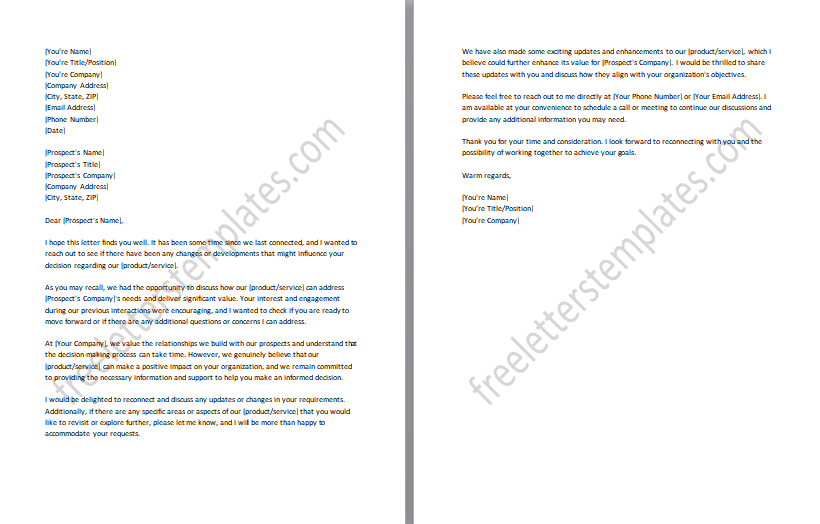
#22: Requesting a Referral or Recommendation:
Ask satisfied customers for referrals or recommendations, leveraging their positive experiences to generate new leads. The purpose of this “Requesting a Referral or Recommendation” letter is to ask satisfied customers for referrals or recommendations, leveraging their positive experiences to generate new leads. This letter aims to capitalize on the satisfaction and trust established with existing customers by requesting them to share their positive experiences with others. This letter serves as a reminder of the value they have received and the impact your offering has made on their business or lives. The goal is to encourage satisfied customers to become advocates for your brand, spreading the word and referring others who could benefit from your solution.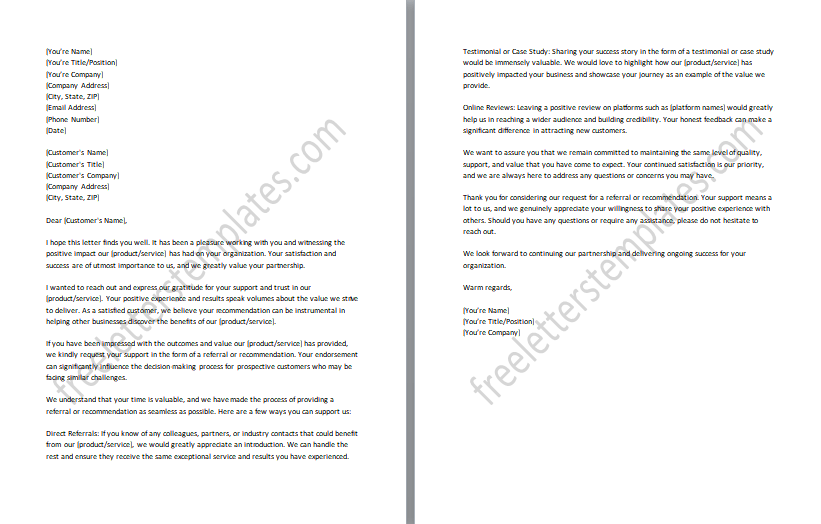
#23: Offering a Discount or Incentive to Close the Sale:
Present a special discount or incentive to motivate prospects to finalize the purchase decision. The purpose of this “Offering a Discount or Incentive to Close the Sale” letter is to present a special discount or incentive to motivate prospects to finalize their purchase decision. This letter aims to create a sense of urgency and provide an added incentive for prospects to take action and make a purchase. By offering a discount or incentive, you provide them with a tangible benefit that adds value to their buying experience. This letter serves as an opportunity to highlight the limited-time nature of the offer and emphasize the potential cost savings or additional benefits they can enjoy by making a decision promptly.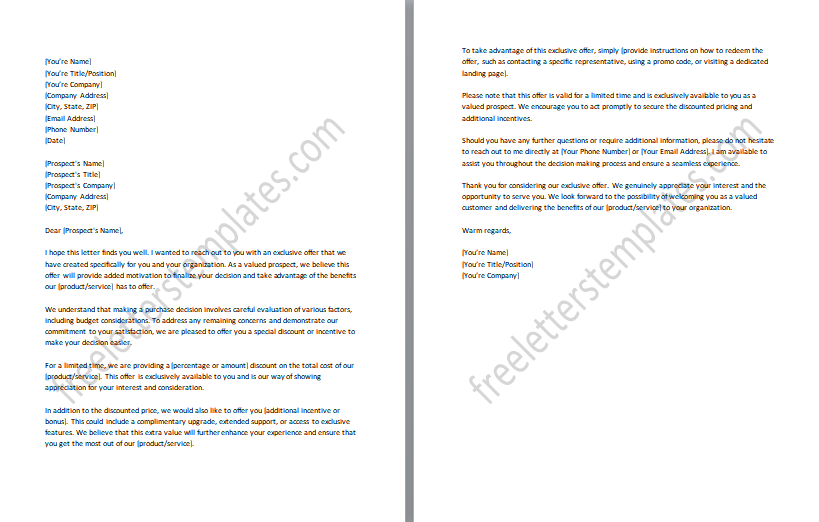
#24: Following Up on a Delayed Decision-Making Process:
Follow up with prospects who have experienced delays in their decision-making process, offering support or addressing any new concerns. The purpose of this “Following Up on a Delayed Decision-Making Process” letter is to follow up with prospects who have experienced delays in their decision-making process. The aim is to offer support and address any new concerns they may have. This letter acknowledges the potential challenges and uncertainties that can arise during the decision-making journey and expresses a willingness to assist the prospect in any way possible. The goal is to provide reassurance, overcome any obstacles, and ultimately guide the prospect toward making a confident and informed decision.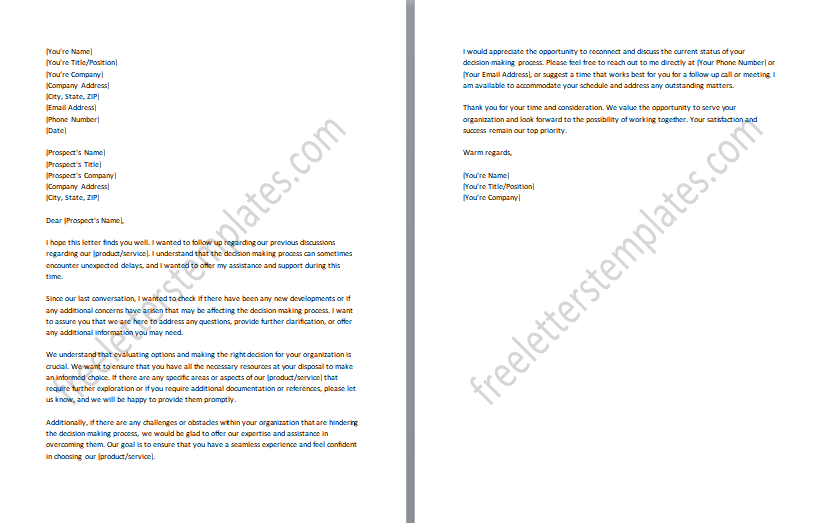
#25: Following Up on an Initial Email or Introduction:
Send a follow-up after an initial email or introduction, ensuring the prospect received the message and offering to provide further information. The purpose of this “Following Up on an Initial Email or Introduction” letter is to send a follow-up after an initial email or introduction to ensure the prospect received the message and offer to provide further information. This letter serves as a gentle reminder and confirmation that the initial communication has been received. By offering further information, you demonstrate your willingness to assist and provide value. The goal is to foster engagement and open the door for further dialogue, moving the prospect closer to a potential business relationship.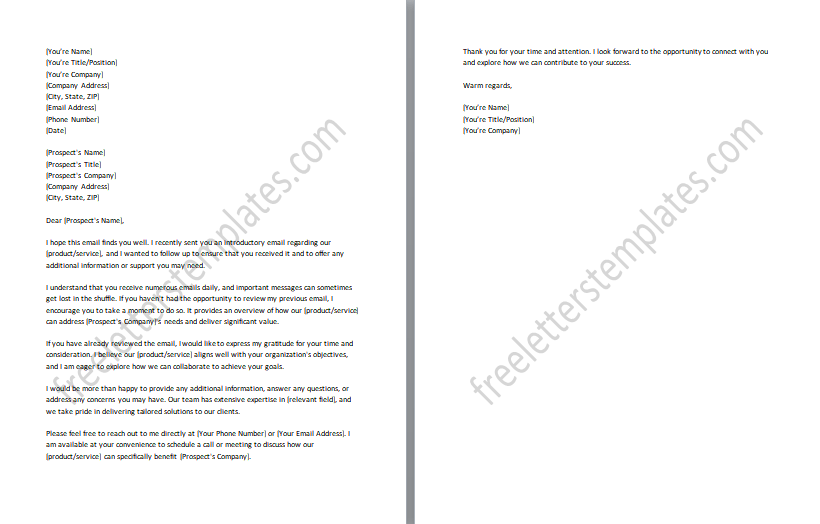
#26: Sending a Reminder about a Limited-Time Offer:
Remind prospects about a limited-time offer or promotion to create a sense of urgency and prompt them to take action. The purpose of this “Sending a Reminder about a Limited-Time Offer” letter is to gently remind prospects about a time-limited offer or promotion. The tone of the letter is friendly and approachable, aimed at creating a sense of excitement and urgency. By reminding the prospects of the limited timeframe, the letter encourages them to take action and seize the opportunity before it expires. The goal is to reignite their interest, motivate them to make a decision and maximize the chances of conversion.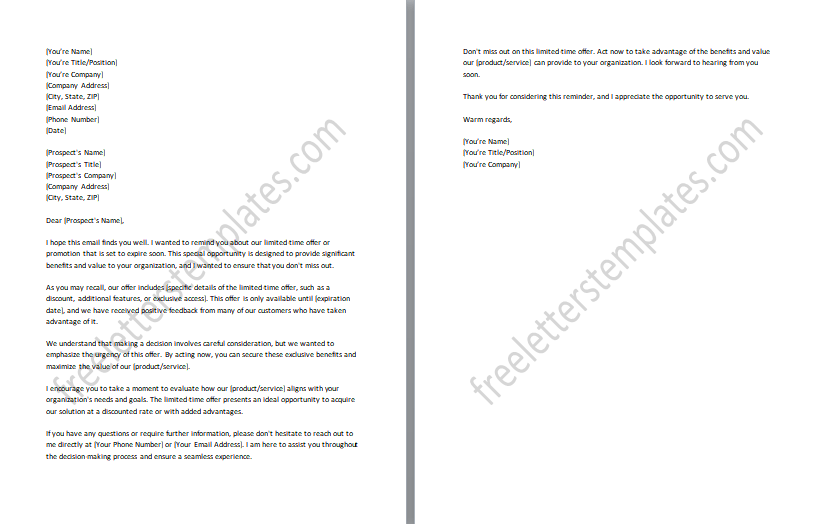
#27: Offering a Free Consultation or Assessment:
Extend an offer for a free consultation or assessment to provide personalized insights and demonstrate your expertise. The purpose of this “Offering a Free Consultation or Assessment” letter is to extend an invitation for a free consultation or assessment to provide personalized insights and demonstrate your expertise. The tone of the letter is professional yet inviting, emphasizing the value and benefits of the offer. By offering a complimentary consultation or assessment, you aim to showcase your knowledge and understanding of the prospect’s needs. This letter serves as an opportunity to highlight the benefits of working with you and how your expertise can address their specific challenges.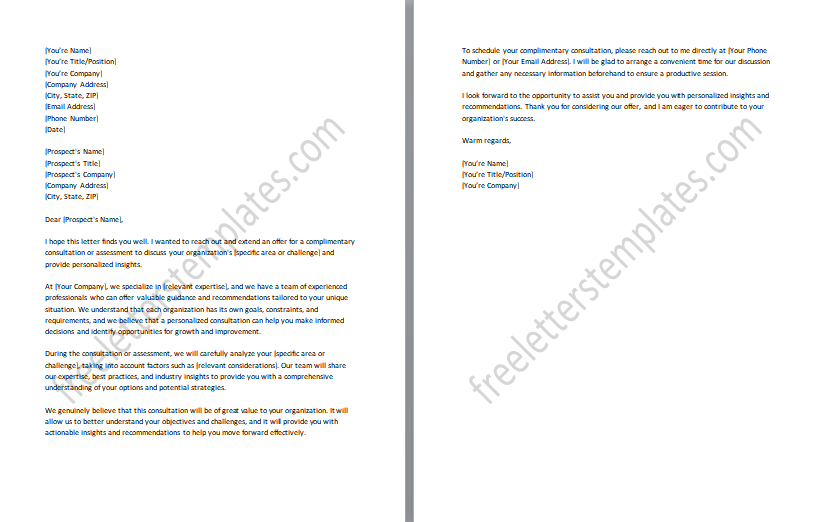
#28: Providing a Guarantee or Risk-Free Trial:
Offer a satisfaction guarantee or risk-free trial to alleviate any concerns and encourage prospects to try your product or service. The purpose of this “Providing a Guarantee or Risk-Free Trial” letter is to offer prospects a satisfaction guarantee or risk-free trial, aiming to alleviate any concerns they may have and encourage them to try your product or service. The tone of the letter is reassuring and confident, emphasizing the value and confidence you have in your offering. This letter serves as an opportunity to address any potential hesitations and demonstrate your commitment to customer satisfaction. The goal is to prompt prospects to take that first step, experience the benefits firsthand, and ultimately convert them into satisfied customers.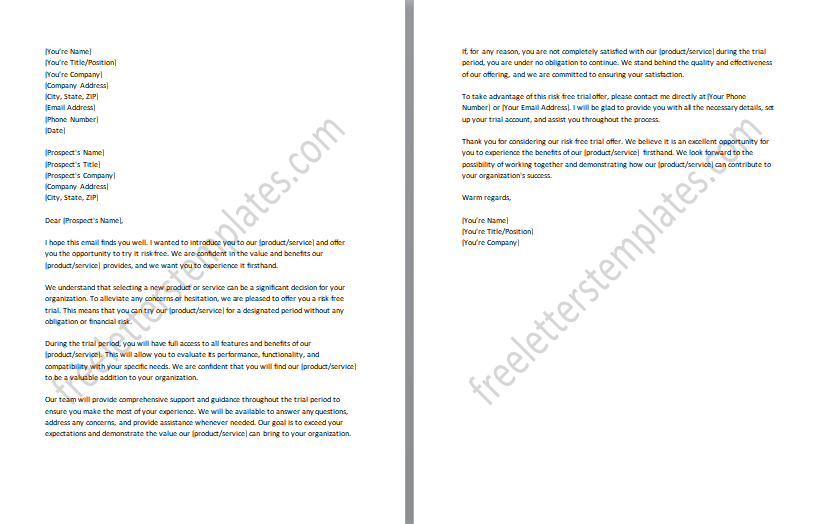
#29: Following Up on an Inquiry or Request for Information:
Follow up on a prospect’s inquiry or request for information, providing the requested details, and offering further assistance. The purpose of this “Following Up on an Inquiry or Request for Information” letter is to follow up on a prospect’s inquiry or request for information, providing them with the requested details and offering further assistance. The tone of the letter is friendly and helpful, aiming to establish a positive connection with the prospect. By promptly addressing their inquiry or information request, you demonstrate your attentiveness and commitment to excellent customer service. The goal is to engage the prospect further, build rapport, and position yourself as a reliable resource they can turn to for guidance and information.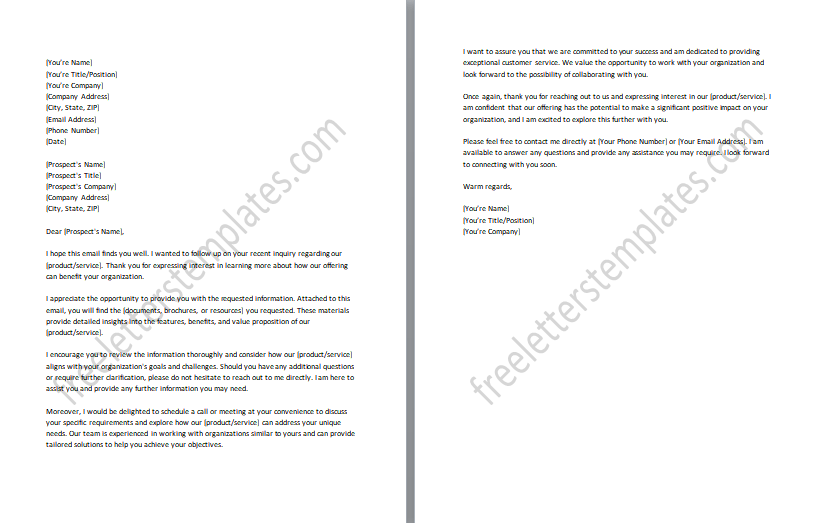
#30: Checking in on Customer Satisfaction after a Purchase:
Follow up with customers after a purchase to ensure their satisfaction, address any concerns, and encourage them to provide feedback or refer others. The purpose of the “Checking in on Customer Satisfaction after a Purchase” letter is to follow up with customers after a recent purchase to ensure their satisfaction, address any concerns they may have, and encourage them to provide feedback or refer others. By reaching out and expressing your genuine interest in their satisfaction, you show your commitment to providing excellent customer service and support. This letter provides an opportunity to address any post-purchase concerns the customer may have, resolve any issues, and gather valuable feedback to continuously improve your products or services.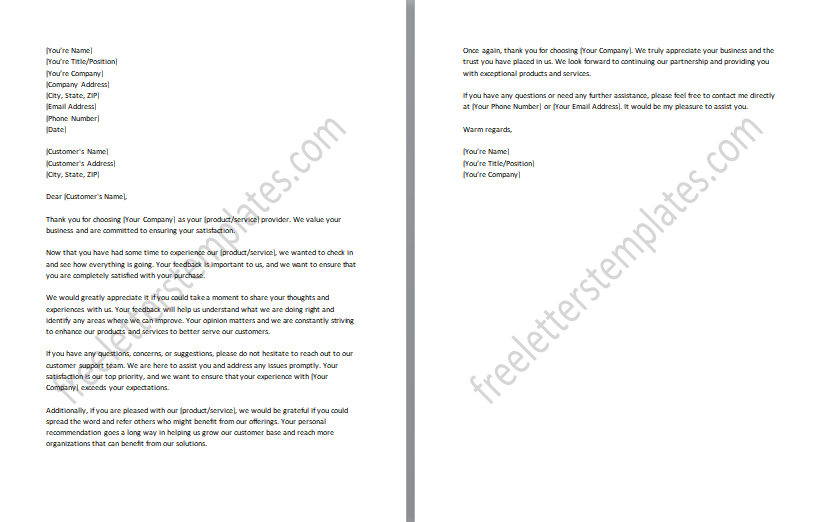
Follow-up Letter Etiquette
- Timing: Send your follow-up letter within a reasonable timeframe after the initial interaction or request. Promptness shows your professionalism and respect for the recipient’s time. Aim to send the follow-up within 1-3 business days, unless there are specific circumstances that require a longer or shorter timeframe.
- Subject Line: Use a clear and concise subject line that reflects the purpose of your follow-up letter. This helps the recipient quickly understand the content and importance of your message.
- Greetings: Start your letter with a polite and professional salutation. Address the recipient by their name if you have it. If you’re unsure about the appropriate level of formality, err on the side of being more formal until you establish a closer relationship.
- Concise and Clear Message: Keep your follow-up letter concise and to the point. Use clear language and avoid jargon or complex terms. State the purpose of your follow-up upfront and provide any necessary details or information.
- Professional Tone: Maintain a professional and courteous tone throughout the letter. Be polite and respectful, even if you are addressing concerns or objections. Avoid using overly casual language or being overly pushy.
- Personalization: Whenever possible, personalize your follow-up letter to make it more relevant and engaging to the recipient. Reference specific details from previous interactions or tailor the content to address their unique needs or challenges.
- Length: Keep your follow-up letter concise and focused. Avoid excessive length or unnecessary details. Ideally, aim for a length that can be easily read in a few minutes. If you have a lot of information to convey, consider attaching additional documents or providing links for further reference.
- Call to Action: Clearly state the desired action or response you expect from the recipient. Whether it’s scheduling a meeting, providing feedback, or making a purchase decision, make it clear what you are asking them to do.
- Closing: End your follow-up letter with a professional closing, such as “Sincerely,” or “Best regards.” Include your contact information, including your name, title, and any relevant contact details.
- Proofread and Edit: Before sending your follow-up letter, proofread it carefully for any spelling or grammatical errors. Ensure that the content is coherent and the message is clear. Consider having someone else review it to catch any overlooked mistakes.
Unlock Your Success: Get Our Free Downloadable Guide
- Introduce the value proposition: Start by highlighting the benefits visitors will receive by accessing the free resource. For example, “Discover the secrets to boosting your sales with our comprehensive downloadable guide.”
- Create a sense of urgency: Emphasize that the resource is available for a limited time or a specific number of downloads. For instance, “Don’t miss out on this exclusive opportunity – download your free guide now before it’s gone!”
- Describe the resource: Briefly explain what the resource offers and how it can help visitors. For instance, “Our guide provides expert strategies and practical tips to overcome common sales challenges, increase conversions, and close more deals.”
- Showcase the value: Highlight the value of the resource by mentioning key features or insights it provides. For example, “Learn proven techniques to build rapport with prospects, negotiate effectively, and master the art of objection handling.”
- Call to action: Use a clear and compelling CTA that encourages visitors to take the desired action. For example, “Get your free guide now!” or “Download your copy today!”
- Capture contact information: Direct visitors to a form where they can provide their name and email address to receive the free resource. Assure them that their information will be kept confidential and used only for communication-related to the resource.
- Reinforce benefits: Remind visitors of the benefits they will gain by accessing the resource. For example, “Unlock the strategies that top sales professionals use to achieve record-breaking results.”
- Thank them: Express gratitude for their interest and assure them that the resource will be delivered promptly. For example, “Thank you for your interest in our guide. You will receive an email shortly with a link to download your copy.
Harnessing the Power of Effective Follow-Up
In closing, it’s clear that effective follow-up plays a pivotal role in today’s competitive business world. By harnessing the power of well-crafted sales follow-up letters, you have the opportunity to truly connect with your prospects, cultivate promising leads, and significantly enhance your chances of sealing the deal. With the right mix of resources and strategies, you’ll not only forge stronger relationships with your customers but also witness a noticeable boost in conversion rates and overall business growth. So, why wait? Take the leap and begin optimizing your follow-up approach today to experience firsthand the incredible impact it can have on your sales success. We sincerely appreciate your recognition of the significance of follow-up in your business endeavors.